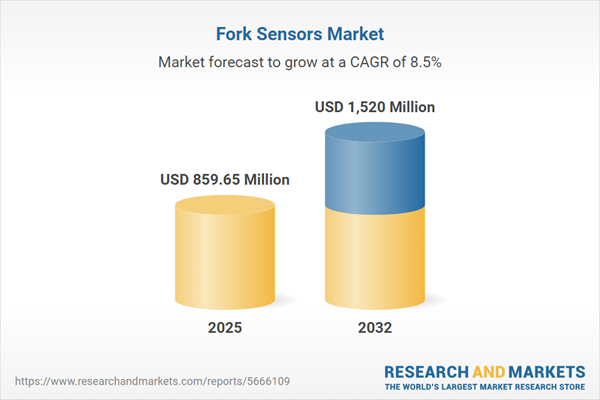Speak directly to the analyst to clarify any post sales queries you may have.
In today's industrial landscape, the rapid evolution of automation and digital transformation is redefining how organizations manage operational efficiency and maintain a competitive edge. The fork sensors market is integral to these advancements, offering decision-makers innovative tools to enhance process control, operational agility, and sustained business growth as B2B environments become increasingly complex and data-driven.
Fork Sensors Market Snapshot
The fork sensors market demonstrates consistent growth, driven by the rising adoption of automation and the expansion of data-centric production frameworks within advanced manufacturing and logistics sectors. According to the latest industry analysis, the global fork sensors market is valued at USD 792.91 million in 2024, projected to reach USD 859.65 million by 2025 and anticipated to approach USD 1.52 billion by 2032. This growth is fueled by a compound annual growth rate (CAGR) of 8.47%, reflecting a robust market trajectory and persistent investment momentum.
Technological innovation and operational efficiencies continue to open new avenues for enterprises, positioning fork sensors as a cornerstone for scalable modernization and durable competitiveness.Scope & Segmentation of the Fork Sensors Market
- Product Types: Wired fork sensors ensure dependable data transfer within automated workflows through support for Ethernet, RS 232, and USB connectivity. Wireless options offer flexibility using Bluetooth Low Energy, Classic Bluetooth, Wi-Fi, and Zigbee, streamlining deployments to match varied operational needs.
- End Users: Solutions address both large enterprises and small or medium-sized businesses, facilitating tailored automation strategies that adapt to unique sector requirements and improving responsiveness to operational challenges.
- Technology: Advanced fork sensors incorporate MEMS platforms equipped with capacitive or piezoelectric sensing elements, alongside optical approaches such as infrared and laser Doppler detection. Ultrasonic variants using Doppler Shift and Time of Flight further expand precision performance in diverse industrial environments.
- Applications: These sensors underpin operational reliability across automotive manufacturing, electronics assembly, material handling, healthcare diagnostics, supply chain automation, and telematics, laying the technological groundwork for effective B2B processes.
- Distribution Channels: Devices are accessible direct from manufacturers or via reputable e-commerce platforms, supporting efficient procurement and strengthening agile supply chain strategies for both local and international markets.
- Regions: Market uptake spans North America, Europe, Asia-Pacific, the Middle East, and Africa. Regional nuances in compliance, infrastructure, and operational workflows ensure optimal sensor performance for diverse global stakeholders.
Key Takeaways for Senior Decision-Makers
- Adopting advanced fork sensors enhances real-time visibility, empowering leaders with immediate process insights and greater oversight of production activities.
- Product advancements such as sensor miniaturization and connectivity improvements foster seamless integration with Industry 4.0 systems, supporting ongoing digital transformation objectives.
- Scalable network architectures offer organizations the agility to expand or reconfigure their sensor infrastructure as operational priorities shift, protecting technology investments.
- Collaboration with system suppliers, software vendors, and integrators helps minimize operational risks and expedites returns on automation investments.
- Technological progress assists organizations in achieving sustainability targets and maintaining compliance, embedding responsible practices within business-critical operations.
- A regionalized approach enables companies to anticipate and address local compliance and infrastructure considerations, strengthening cross-border reliability and continuity.
Tariff Impact on Supply Chain and Innovation
Recent modifications to US electronics tariffs have prompted fork sensor manufacturers to diversify supply chain partnerships and intensify engagement with key suppliers. These initiatives optimize procurement efficiency, reinforce risk management, and encourage focused innovation to maintain reliable delivery and market competitiveness in a shifting regulatory environment.
Methodology & Data Sources
This report synthesizes findings from comprehensive market analysis, a thorough evaluation of regulatory documentation, and direct collaboration with industry stakeholders throughout the supply chain. All insights undergo strict validation to ensure accuracy and executive relevance.
Why This Report Matters
- Facilitates structured planning and effective resource deployment amid technologically evolving industrial operations.
- Supports procurement and compliance frameworks that harmonize risk management and governance objectives for optimal B2B outcomes.
- Provides actionable insights to maximize sensor network returns, enabling greater operational resilience and fostering sustainable organizational growth.
Conclusion
Fork sensors are pivotal in enabling advanced industrial automation, empowering organizations to achieve higher efficiency and prepare for evolving operational demands. Strategic commitment to these technologies enhances long-term competitiveness and organizational resilience.
Additional Product Information:
- Purchase of this report includes 1 year online access with quarterly updates.
- This report can be updated on request. Please contact our Customer Experience team using the Ask a Question widget on our website.
Table of Contents
3. Executive Summary
4. Market Overview
7. Cumulative Impact of Artificial Intelligence 2025
Companies Mentioned
The companies profiled in this Fork Sensors market report include:- Mettler-Toledo International Inc.
- Rice Lake Weighing Systems, LLC
- Avery Weigh-Tronix Limited
- CAS Corporation
- Cardinal Scale Manufacturing Company
- Intercomp Company
- Flintec AB
- Rinstrum Pty Ltd
- Vishay Precision Group, Inc.
- Hunan Weighing System Co., Ltd.
Table Information
| Report Attribute | Details |
|---|---|
| No. of Pages | 199 |
| Published | October 2025 |
| Forecast Period | 2025 - 2032 |
| Estimated Market Value ( USD | $ 859.65 Million |
| Forecasted Market Value ( USD | $ 1520 Million |
| Compound Annual Growth Rate | 8.4% |
| Regions Covered | Global |
| No. of Companies Mentioned | 11 |









